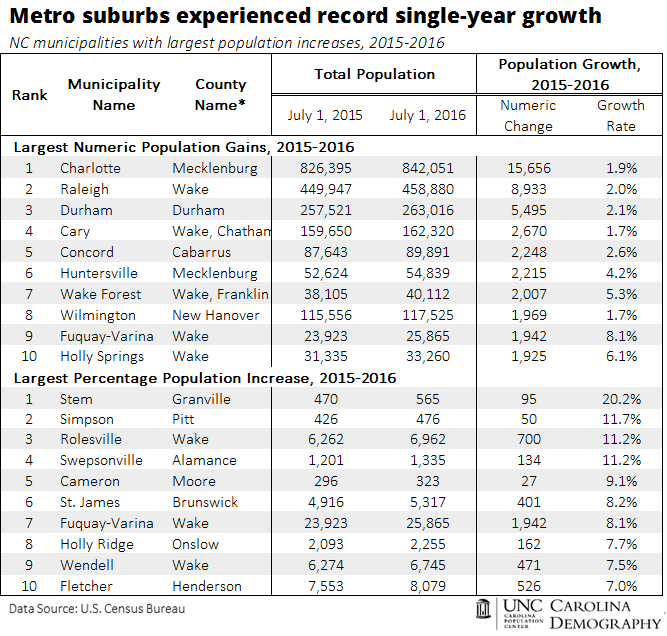NC Municipal Growth, 2016 Annual Update

The U.S. Census Bureau recently made its 2016 population estimates available, and the topline trends for North Carolina has maintained a nearly identical trajectory as 2015. Since the last decennial Census in 2010, North Carolina has seen its urban metropolitan areas grow consistently larger, while small, often rural municipalities have struggled to maintain population.
North Carolina’s two largest metropolitan statistical areas – Charlotte-Concord and the Triangle (Raleigh-Durham-Chapel Hill) – have driven much of North Carolina’s total growth since 2010, accounting for 72% of the state’s 611,000 person growth. For every one-year period since the last census (e.g. 2010-2011, 2012-2013, etc.), the cities of Charlotte, Raleigh, Durham, and Cary have reported the largest numeric gains in population, typically in that order. Greensboro and Winston-Salem of the Triad, and the port communities around Wilmington, have also made significant gains since 2010.
 Note: while some municipalities cross multiple counties, Cary, Wake Forest, and Morrisville are located primarily in Wake County.
Note: while some municipalities cross multiple counties, Cary, Wake Forest, and Morrisville are located primarily in Wake County.While the topline trends have been consistent over the past few years, 2015 to 2016 was a unique year for North Carolina’s population. It was the single largest year of growth for the state since 2010, as well as for 140 of its 553 municipalities. Of these municipalities, a number had significant population additions after having had consecutive years of negative or single-digit gains, a topic I will explore more in an upcoming post. The major trend seen in 2016 was the expansion of suburbs around metro areas. This growth occurred in both well-established municipalities and small, less populated ones.
Of the cities and towns with the largest population gains since 2015, 9 out of 10 were from the Triangle or Charlotte. These have pushed the municipalities of the Triad out of the top 10. The county populations of Guilford (Greensboro) and Forsyth (Winston-Salem) are projected to stabilize for the next decade, in contrast to the continued growth in the core counties in the Charlotte and Raleigh-Durham-Chapel Hill metros.
Municipalities with the fastest growth from 2015-2016 reveal new trends that may be emerging in North Carolina. Small- and medium-sized suburbs in metropolitan areas saw growth that was much larger than their recent historical averages. While a number of municipalities were located near the Triangle, new metro areas were also represented around Greenville, Burlington, and Jacksonville.
A breakdown of some of these fastest-growing municipalities:
Whether the 2016 population estimates are the beginning of a new growth pattern in North Carolina remains to be seen. If these trends continue, we may see an uptick of growth in the state’s suburban and ex-urban areas near fast-growing metropolitan areas.
 Note: while some municipalities cross multiple counties, Cary and Wake Forest are located primarily in Wake County.
Note: while some municipalities cross multiple counties, Cary and Wake Forest are located primarily in Wake County.
Need help understanding population change and its impacts on your community or business? Carolina Demography offers demographic research tailored to your needs.
Contact us today for a free initial consultation.
Contact UsCategories: Carolina Demographics
Tags: metro areas, municipalities, population estimates, suburbs, U.S. Census Bureau

The Center for Women’s Health Research (CWHR) at the University of North Carolina School of Medicine released the 12th edition of our North Carolina Women’s Health Report Card on May 9, 2022. This document is a progress report on the…

Dr. Krista Perreira is a health economist who studies disparities in health, education, and economic well-being. In collaboration with the Urban Institute, she recently co-led a study funded by the Kate B. Reynolds Foundation to study barriers to access to…

Our material helped the NC Local News Lab Fund better understand and then prioritize their funding to better serve existing and future grant recipients in North Carolina. The North Carolina Local News Lab Fund was established in 2017 to strengthen…
Your support is critical to our mission of measuring, understanding, and predicting population change and its impact. Donate to Carolina Demography today.